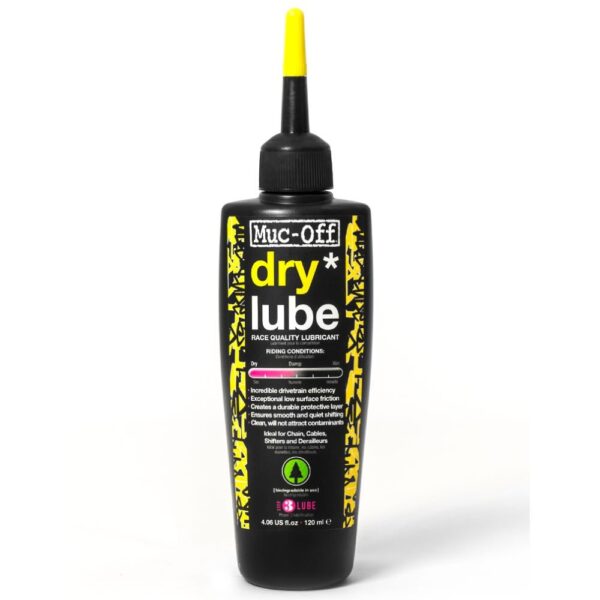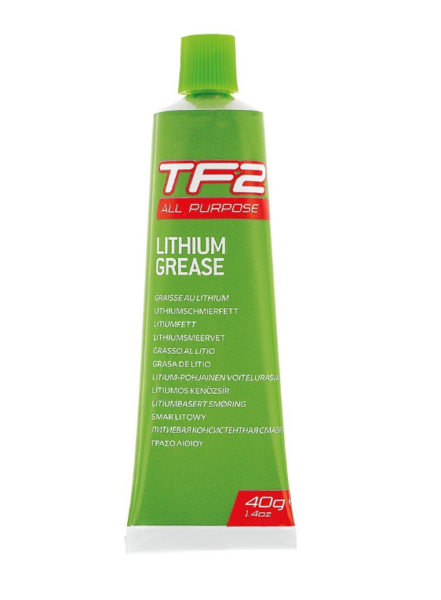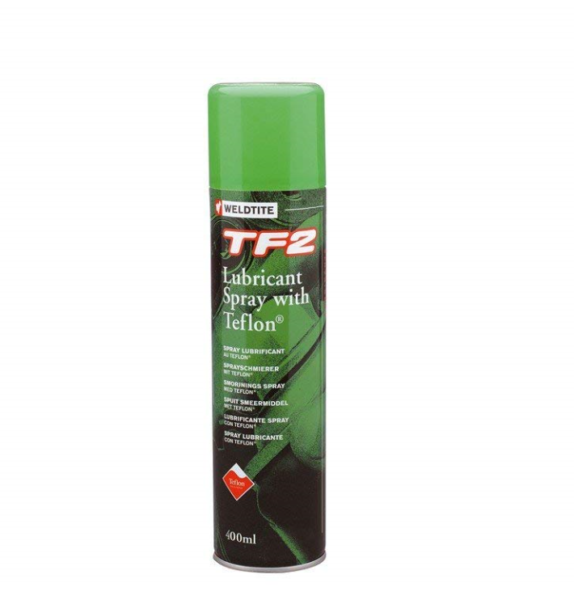The variety of lubricants in your local bike shop can be a little confusing, vital for maintaining your bicycle and keeping things moving smoothly, they prolong the life of parts and improve your ride if applied correctly. If you’re not sure which parts of the bike need lubrication then this blog will guide you through.
There’s essentially three different types of bike lube:
- Chain Lubricants (Dry/Wet)
- Grease
- All Purpose Lubricants
Chain Lubricants (Dry/Wet)
Dry and wet are pretty much universal terms and most chain lubricant manufacturers will offer these two variants as a minimum. As a very simple rule of thumb, use dry lubes in dry conditions and wet lubes in wet conditions.
Dry Lubricants
These go onto the chain wet, but then dry to a waxy finish. Most take a few hours to dry, so plan for this before you head out to ride. The positive side of a dry lube is it won’t collect much dirt which is perfect for cycling in dry conditions. On the downside, dry lubes wash off very easily and will need re-applying after a wet ride.
Wet lubricants
Wet lubes are thicker and stick to the chain, remaining wet to the touch until rubbed away. They are perfect for wet conditions, as they offer a highly increased resistance to rain and are harder to wash away. The downside is they collect dirt so need cleaning up a lot more regularly to stop damage to components.
Wet lubes should only really be used when the conditions call for it. They are perfect for your winter bike in harsh conditions, but clean up the chain and swap back to dry lubes in the summer to prevent grime building up within the cassette.
Can I Use Other Types of Lubrication On My Chain?
In short, no. Chain lubes are made specifically for the task so there’s little need to stray elsewhere. The classic beginner mistake is to use a very lightweight household oil such as WD40, which is designed for low use parts. Whilst this will grease the chain in the short term, it is not meant for outside use and will very quickly wash away. The other extreme is motor oil. This is generally too thick for use on a bike chain, and will not penetrate the smaller parts of a bike. It is also very sticky, so will pick up muck from the road very easily.
How to Use
Clean your chain
Before applying lubricant, get the chain as clean as possible. There is no point lubricating over dirt as this will continue to grind around all of your key components.
If your chain is in a particularly dire state you could use a scrubbing tool, but usually a rag and degreaser will do fine. Remember to also clean in the cassette and around the jockey wheels.
Application
The best way to apply lube is with your bike in a stand or the back wheel off the ground. Apply one drop of lube into every chain link and work the pedals around gradually until you have completed every section. Then run the bike through as many of the gears as possible to force the lube into the inside parts of the links where it is most needed.
Wipe down
As a new rider, leaving excess lube on the chain was the first thing I got told off for when I took my bike in for its initial service. The key place for the lubricant to be working on is the internal parts of the chain, so you shouldn’t expect to see it coated on the outside.
When you have applied the lube and run it through the gears a few times, grab an old piece of rag and gently wipe the chain down to remove any excess. This should stop too much grit being able to stick to the outside. If you have used a dry lube leave it for a few hours so it has dried out completely before taking it for a ride.
How often should I lubricate the chain?
How long is a piece of string? There are so many variables here so it’s almost impossible to say, though I work with a general rule of about once a month, maybe slightly more in bad conditions.
With experience you can feel when the chain doesn’t move so smoothly and then react accordingly. Don’t feel like you have to relubricate every time you give your bike a wash, as in the long run all this will do is cause more grime to stick to the chain.
Products
I personally have always used the Muc Off range of chain lubes, simply because it was the first range I bought and I’ve never seen a reason to change over as I’m happy with the results. I keep a bottle of both wet and dry in my toolkit so I’m ready for any weather.

Grease
Grease is a heavier, waterproof lubrication which is generally used in places on the bike you don’t take apart or see too often. It has two key, but quite different functions:
- To keep key components moving and free from water entering
- To help places of static metal to metal connection from seizing up
In the first instance grease is heavily used to keep moving parts of the bike running freely. You will find it in the bearings of your wheels, bottom bracket and headset and also in the moving parts of your brakes and gear levers. You will not find grease in moving parts that are open to the air as, due to its thick and sticky texture, it would attract dirt too easily.
In the second instance grease is used to prevent parts from seizing up or ‘cold welding’. Again, these parts will all be shielded from the elements.
The key static areas on which to use grease are saddle posts and bolt threads. These components sit against metal for long periods of time under pressure, and can seize up making them very difficult to remove. I would recommend greasing any bolt before tightening on a bike, and once every few months removing your saddle post, cleaning it down and regreasing to prevent it seizing to the frame.
Products
I use Lithium Grease by Weldtite, as I was introduced to it by a local mechanic *insert joke here* and have never tried anything else. It is perfect for both examples described above and lasts ages. The grease is white which helps you see where it has been applied.

All Purpose Lubricants
All purpose lubricants are your day-to-day workhorses for keeping the bike moving. It is best to invest in something that has a waterproof element such as teflon and is suited to outdoor use.
For an all purpose lubricant, products in spray cans make application easier especially when blasting it into those hard to reach areas like down cable housing. All purpose lubricants have a whole host of uses like freeing up a sticking brake cantilever, stop a squeaking pedal, get your brake cables shifting smoother and a lot more besides.
As with all types of lubricant, make sure you clear off any excess as, being quite thin, this can easily run down onto brake pads or other areas of the bike you don’t need it.
Products
My favourite is again by Weldtite, the TF2 Aerosol Spray. This spray contains Teflon which helps to make it more waterproof, and has one of those handy red tubes for spraying it into hard to reach places.

